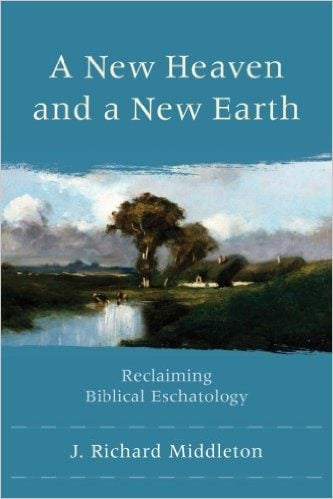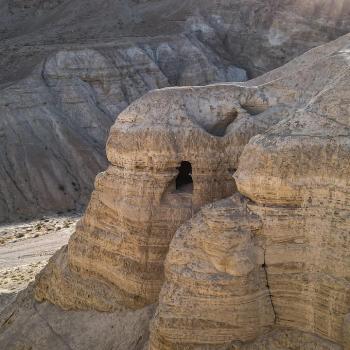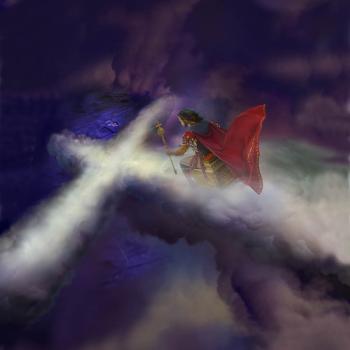Dr. J. Richard Middleton is professor of Biblical Worldview and Exegesis at Northeastern Seminary in Rochester, New York. He is the author of A New Heaven and a New Earth: Reclaiming Biblical Eschatology (Grand Rapids: Baker Academic, 2014, pp. 332). It has received critical acclaim and has stellar endorsements, including from Walter Brueggemann and Donald A. Hagner. One of them says, “this sorely needed volume is the best book of its kind.” In 2014, it received the Word Guild Award as the best book in biblical studies that year.
I have specialized in the study of biblical eschatology for over fifty years. So, I am always delighted to read a good book on this genre. And I was especially interested in this one because its title indicates that it is about an important subject in eschatology that one of its endorsements says is “a key biblical theme that is all too often neglected in academic circles.” Yet this book’s subject matter is the eternal destiny of the saints, which should be of interest to all of them.
I like this book even though I disagree with a few of its minor points. Middleton is a good researcher and knows the secondary literature on this subject (although there isn’t that much). Yet you wouldn’t know it at first glance since Baker Academic didn’t require Middleton to furnish a bibliography or author index, which is not very academic. The authorial style is quite accessible. However, Middleton commits the bane of scholars with too much prose material in footnotes. Chicago Manual of Style recommends against this, even for academicians.
I will only do here a partial review of A New Heaven and a New Earth. I fully subscribe to Middleton’s primary thesis in this book. It is that nearly all Christians believe heaven is their eternal destiny, whereas the Bible teaches to the contrary, that God’s people will live on a transformed earth. John, the author of Revelation, says, “I saw a new heaven and a new earth; for the first heaven and the first earth had passed away, and the sea was no more. And I saw the holy city, the new Jerusalem, coming down out of heaven from God” (Rev 21.1-2). I think the “sea” being “no more” indicates its saltwater will be replaced with freshwater. Saltwater obviously has its limitations: it cannot be used for drinking or for growing crops.
Middleton also does not address the difference between the singular for “heaven” in Revelation and its plural in Isaiah: “a/the new heavens and a/the new earth” (Isaiah 65.17; 66.22 NRSV). These three texts are the Bible’s only mention of this expression. The singular in Revelation has led some to think it refers to the heaven where God dwells whereas these two Isaiah texts seem to refer to the heavens of the universe, thus referring to all of God’s creation. But “the first heaven and the first earth” in Rev 21.1 clearly refer to original creation.
(The Hebrew word for “heaven” is shamayim. Its plural ending, yim, is like elohim, the Hebrew word for “God/God,” in that it can mean either singular or plural. In both Isaiah 65.17 and 66.22 in MT, the adjectives “new” that modify “heaven” are plural but singular modifying “earth.” So, in both Isaiah texts, shamayim must be understood in the plural, signifying “the heavens” of the universe. However, the LXX does render “heaven” in both Isaiah texts in the singular.)
Middleton rightly says this coming down of new Jerusalem from heaven will occur at the yet future eschaton, when God establishes “a new heaven and a new earth” (v. 1). However, Middleton does not make a distinction between the heaven where God dwells and the heavens of creation. This omission allows Middleton to say (pp. 71-72, “Heaven was never part of God’s purposes for humanity in the beginning of the story and has no intrinsic role as the final destiny of human salvation.” I don’t think that is quite right, which will become evident as I proceed. Middleton continues, “In Scripture the term ‘heaven’ (or the ‘heavens’) represents, first of all, part of the created universe…. the creator has chosen to dwell within the created universe…. this transcendent part of the created order is pictured as the location of God’s throne room.”
If so, where was God, not to mention angels, before or when he created the universe? I think this question and science’s discovery of big bang require God being outside the universe. So, Middleton does not distinguish between “the heavens,” referring to creation, and “the heaven” where God dwells. This is a difficulty in scripture. The New Testament (NT) sometimes refers to “the heavens” of creation with the singular (Gr. ouranos). But I think the heavens of creation should be distinguished from God’s abode in heaven. When Jesus said to pray, “Our Father, who is in heaven,” and “Your will be done, on earth as it is in heaven” (Matt. 6.9-10), he must have meant heaven in distinction from the heavens of the universe. Thus, I accept the old three-tiered concept of heaven literally above the cosmos as the best fit with scripture.
Middleton assumes that the new Jerusalem will be on earth, so he doesn’t discuss alternative views. I contend that can’t happen for various reasons, one being its size. Revelation 21.16 says, “The city lies foursquare, it length the same as its width;… fifteen hundred miles; its length and width, and height are equal.” Like most commentators on Revelation, Middleton (pp. 170-71) interprets this description as cube-shaped, with the height and each side 1,500 miles long. Such a monstrosity not only seems bazaar for the shape of a city, but it would not fit present earth. Biblical prophecies of a renovated or transformed earth in the eschaton (not another created earth that replaces it) indicate that the new earth will be comparable to its present size.
Middleton and commentators on Revelation should know that ancient cities were measured by their circumference. Thus, “three days” in Jonah 3.3 make no sense unless they are understood as how long it took to walk the circumference of ancient Ninevah. In my book, Warrior from Heaven (p. 213), I explain concerning new Jerusalem “It is a great and high mountain that is much more massive than earthly Jerusalem. New Jerusalem is shaped foursquare at its bottom, with each side being 375 miles long, making its perimeter measure 1,500 miles. Not only is the city’s length and width equal, so is its height. But this does not mean the city is cube-shaped; rather, it is shaped like a mountain, with its peak rising up at its center to measure 375 miles high.” (See my post, “Will Holy New Jerusalem Be Cube-Shaped?”)
John the Revelator only says the new Jerusalem comes down out of heaven; he does not say where it locates. Thus, it is an assumption to say it be on earth. Due partly to its huge size, I speculate that new Jerusalem will hover over earth, with both connected by a stairway/ramp which Jesus symbolizes by joining God’s heavenly city with renovated earth (Genesis 278.17; John 1.51). In fact, the size and perhaps the shape of the base of new Jerusalem approximates the entire promised land on earth. Perhaps it will serve as a canopy to protect the promised land from sunlight. Another reason is that scripture says of the earth, “day and night, shall not cease” (Genesis 8.22), whereas in new Jerusalem, “there will be no more night” (Rev 22.5). Thus, I distinguish between the Jerusalem on the new earth and new Jerusalem “above” (Galatians 4.26). Ezekiel 48.16 says the circumference of that earthly Jerusalem will measure about six miles. See my Warrior from Heaven, p. 181.)
I further concur with Middleton in his saying (p. 174), “we have to get rid of the unbiblical idea of ‘going to heaven’ as our final destiny.” Middleton (pp. 132-36) rightly says that at death, human souls go to Sheol, not heaven, to await resurrection. Middleton (pp. 131-54) emphasizes the importance of the resurrection of God’s people and says Jesus’ resurrection parallels the future transformation of heaven(s) and earth. He (pp. 227-31) later well states that the two main biblical texts that Christians cite to support their view of going to heaven when they die—2 Corinthians 5.1-8 and Philippians 1.21-23—do not teach that.
Middleton sometimes seems influenced by Tom (N. T.) Wright in his emphasis on God’s future return to Zion with a de-emphasis, if not ridicule, of Christ’s second coming. For example, he states (p. 222), “First Thessalonians 4:13-18 is the classic ‘rapture’ text. However, it does not intend to teach some esoteric doctrine about the second coming.” Heh, let’s ignore the Dispensationalists favorite term “rapture” for this text. Paul says therein of dead saints, “through Jesus, God will bring with him those who have died” (1 Thess. 4.14). Paul means Jesus’ yet future return, which Christians have well termed “the second coming of Christ,” when “the dead in Christ will rise first” (v. 16). Middleton then says (p. 225), “The text is not about removal of believers from earth at all.”
On the contrary, Paul teaches in 1 Thes 4.13-18 what Jesus taught in his Olivet Discourse and John 11.25-26 since Paul says, “by the word of the Lord” (v. 15). Jesus had said, “the Son of Man will appear in heaven” (Matt. 24.30). (Here is an example of the Greek word ouranon being in the singular, yet referring to the heavens of the cosmos.) Jesus adds concerning himself as Son of Man, “he will send out his angels with a loud trumpet call, and they will gather his elect from the four winds, from one end of heaven to the other” (v. 31). This is the same trumpet Paul mentions in 1 Thes 4.16. How did those elect get in the sky? God raised them from the dead, as Paul says, and further raised them into the sky all over the earth. The angels then gather them together, which I believe is over earthly Jerusalem because Jesus will descend from there to destroy his enemies and deliver Jews there from annihilation begun by the nations militaries headed by the Antichrist.
Middleton often characterizes his view of a future, transformed heaven(s) and earth, with believers living on earth in Jesus’ kingdom, as a “holistic eschatology.” I concur. In a large appendix (pp. 283-312), he rightly documents how early church fathers taught this, but Augustine, especially in City of God, taught otherwise, that Jesus’ promised kingdom had been fully realized in the church, thus departing from the scriptural view of God’s transformation of heaven(s) and earth in what is still future for us, when God’s kingdom on earth with be fully consummated at Jesus’ return.
Overall, I recommend Middleton’s A New Heaven and a New Earth. It will stimulate the thinking of Bible students, especially those who cherish the Bible’s eschatological teachings.












